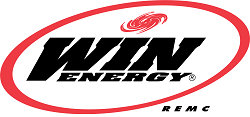Alternative sources of energy are gaining ground as costs drop, efficiencies improve, and consumers, lawmakers, regulators and utilities all seek cleaner solutions for the environment when it comes to how we generate electricity and use electricity.
Indiana’s electric cooperatives have been diversifying their power portfolios for over two decades — even before renewable mandates and stiffer new federal regulations entered the conversation. Here are some ways they generate and use alternative power:
Landfill methane gas projects. Indiana’s two co-op power suppliers — Hoosier Energy REC and Wabash Valley Power Association — have developed landfill gas-to-electricity stations.
Methane is a naturally occurring byproduct of the decaying waste at a landfill and is 20 times more potent as a greenhouse gas than carbon dioxide. It’s been traditionally converted to CO2 by being flared off. Landfill generating facilities instead capture the gas and burn it to run generators that make electricity.
Over the past 20 years, Wabash Valley has developed 15 facilities across north and central Indiana in cooperation with Waste Management landfills. These landfill facilities supply 47 megawatts of baseload capacity. Wabash Valley has one of the largest landfill gas fleets among electric cooperatives nationwide.
Hoosier Energy operates a facility in southern Indiana and one in Illinois and will bring another online in Illinois in June. It’s also in the process of developing another in eastern Indiana.
Coalbed methane. Much like landfill gas projects, Hoosier Energy collects methane that builds in coal beds from 58 wells drilled in Sullivan County and uses it to power generators. Its Osprey Point Renewable Energy Station opened in 2013 at its Merom Generating Station.
Anaerobic digesters. Wabash Valley has purchase agreements for electricity generated from the methane created by cattle and pig waste at the large dairy and pig farms at Fair Oaks in northwestern Indiana.
Hydropower. Hoosier Energy purchases electricity produced at a hydro plant on the Fox River near Ottawa, Illinois, southwest of Chicago.
Solar. Beginning last year, Hoosier Energy began a three-year project building 1 MW solar farms in 10 areas it serves in Indiana and Illinois. Wabash Valley is building five smaller farms in areas it serves in Indiana, Illinois and Missouri.
Meanwhile, individual electric cooperatives on their own are building or investigating community solar projects. Tipmont REMC, for example, which serves primarily Tippecanoe and Montgomery counties, installed 240 photovoltaic panels in 2014. It leases the output of the panels to consumers who want to invest in solar but either cannot or do not want to invest in panels and installation at their own homes.
The community solar project was the focus of last April’s Electric Consumer cover story.
National Renewables Cooperative Organization. Both power suppliers are charter members of the Carmel-based NRCO which develops renewable energy projects for co-ops. Wabash Valley’s CEO, Jay Bartlett, is the current president of the organization.
Conservation/efficiency. While not “generating” electricity per se, the myriad of conservation/efficiency programs Indiana’s electric co-ops offer and encourage consumers to participate in follow the idea that the cleanest, most affordable kilowatt-hours are the ones that weren’t needed and, therefore, weren’t generated. Be sure to look in Electric Consumer for info and rebates on heating/cooling equipment, water heaters, recycling programs, the Touchstone Energy Home building program and more.
“The co-ops have been focused on this long before it was trendy and cool,” said Heath Norrick, Hoosier Energy’s manager of renewable energy, “because the right thing to do is to help members use less and save more.”



